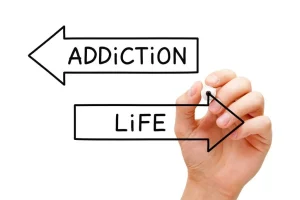
Genetic, psychological, social and environmental factors can impact how drinking alcohol affects your body and behavior. Theories suggest that for certain people drinking has a different and stronger impact that can lead to alcohol use disorder. Alcohol causes the release of dopamine in the ventral tegmental area, which is a part of the reward pathway. The fact that not every person who drinks alcohol will necessarily experience a loss of control and progression to addiction indicates that AUD is not solely driven by exposure to alcohol. As mentioned, genetic and environmental susceptibilities are not fully understood. This activity reviews the definition and diagnosis of AUD and the available evaluation and evidence-based treatments.
Physical Signs of Alcoholism
In a primary alcohol, the carbon with the OH group has 1 alkyl group attached to it. In a secondary alcohol, the number of attached alkyl groups is 2. According to the 2017 National Survey on Drug Use and Health (NSDUH), 51% of the population aged 12 and older reported binge drinking in the past month. According to the National Institute on Alcohol Abuse & Alcoholism (NIAAA), women who have no more than 3 drinks on a given day and no more than 7 per week are at low-risk for developing AUD. Alcohol use disorder (AUD) is a chronic, relapsing disease that is diagnosed based on an individual meeting certain criteria outlined by the Diagnostic and Statistical Manual of Mental Disorders (DSM-5). In some people, the initial reaction may feel like an increase in energy.
AA Video for Legal and Corrections Professionals
Loved ones can provide immeasurable support, but they almost take care of themselves throughout an often difficult journey. There are many organized programs that provide the support of peers, usually through frequent meetings. Alcoholics Anonymous is one example; it offers a structured 12-step path toward recovery with a community of support from those who have dealt with similar challenges. Alcohol is a powerful substance, with the capacity for positive experiences, such as bursts of creativity and fun, as well as harmful repercussions, such as addiction and health problems. Becoming dependent on alcohol can lead to challenges for both the mind and the body. For more information on symptoms, causes, and treatment of alcohol use disorder see our Diagnosis Dictionary.
Coping and support
There’s no medical test that proves you have a drinking problem. Instead, experts follow the criteria for alcohol use disorder that are listed in the Diagnostic and Statistical Manual of Mental Disorders, Fifth Edition (DSM-V). It’s a list of questions about your drinking habits, and how alcohol 6 myths about alcohol use affects your daily life and relationships. Your answers can help a doctor understand if you have AUD, and whether it’s mild, moderate, or severe. Alcohol use disorder is considered a progressive disease, meaning that the effects of drinking alcohol become increasingly more severe over time.
How is alcohol use disorder diagnosed?
To learn more about this particular chronic illness, read the following 15 facts. Before we jump into the facts about alcoholism, let’s first define what it means. Alcoholism, or Alcohol Use Disorder (AUD), as it is more clinically known, is characterized by uncontrolled drinking due to physical and emotional dependence and preoccupation with alcohol. In some cases, it may also be referred to as alcohol dependence. Affecting more than 27 million individuals nationally, alcohol is the most abused drug in The United States. Although it may seem counterintuitive, suddenly cutting yourself off from all alcohol when you’re a heavy drinker can also become a medical emergency.

If loved ones question you, you may lie about how much you’re drinking. While the exact causes of alcoholism are not known, a number of factors can play a role. The condition is likely the result of a combination of genetic, social, psychological, and environmental factors. In order to be diagnosed with AUD, a person must experience any two of these symptoms within the same 12-month period. Finally, epidemiologists need a definition of alcoholism that enables them to identify alcoholics within a population that may not be available for individual examination. Mutual-support groups teach you tactics to help you overcome your compulsion to drink alcohol.

The Healthcare Professional’s Core Resource on Alcohol from NIAAA

Alcohol use disorder involves a loss of control over the ability to drink moderately. This loss of control results in negative consequences that impact relationships, physical and mental health, and the ability to fulfill role obligations. Alcohol is used in increasing amounts to achieve the same effect, a phenomenon known as tolerance, and its absence results in withdrawal symptoms. Patients with AUD experience intense cravings for alcohol that drive ongoing consumption. An informed minority opinion, especially among sociologists, believes that the medicalization of alcoholism is an error. Unlike most disease symptoms, the loss of control over drinking does not hold true at all times or in all situations.

But as you continue to drink, you become drowsy and have less control over your actions. Having support and seeking professional treatment increases the chances for recovery from AUD. Groups such as Alcoholics Anonymous (AA) provide support for people who are recovering.
Prevention of Alcohol Use Disorder

Eventually, the more someone drinks, the more their bodies depend on alcohol, as what was once enough for someone slowly increases over time. The more you drink, the more likely you are to suffer from addiction and more severe health problems as alcohol is a highly addictive substance. Alcohol dependence develops over time and depends on many different factors like genetics and other environmental factors. According to a 2014 study by the World Health Organization, alcohol misuse was the first leading risk factor in premature deaths worldwide. Further, alcoholism contributed to 21.3 percent of deaths caused by liver cirrhosis, cardiovascular diseases, tuberculosis, pancreatitis, and HIV/AIDS. If you have a parent or sibling struggling with alcoholism, you are four times more at risk of developing alcoholism than individuals without a family history.
A.A. Can Support Professionals
- They can research alcoholism to understand the underpinnings of the disorder, the signs of an overdose, and other important information.
- They may drink to calm down or loosen up in social settings.
- Despite these alarming statistics, only roughly 7.2 percent of people receive treatment.
Though it is well known that individuals with addiction are often highly stigmatized, the judgment and stigma attached to sobriety is also very real. The name “phenol” refers both to the family of molecules with an OH group attached to an aromatic ring and the simplest member of that family, C6H5OH. Phenols have a number of characteristics that are very different from normal alcohols. For example, thanks to their ability to form resonance structures, phenols are way more acidic than normal alcohols. Thus, the reactivity of phenols is different from normal alcohols, allowing them to participate in reactions that normal alcohols typically don’t.
